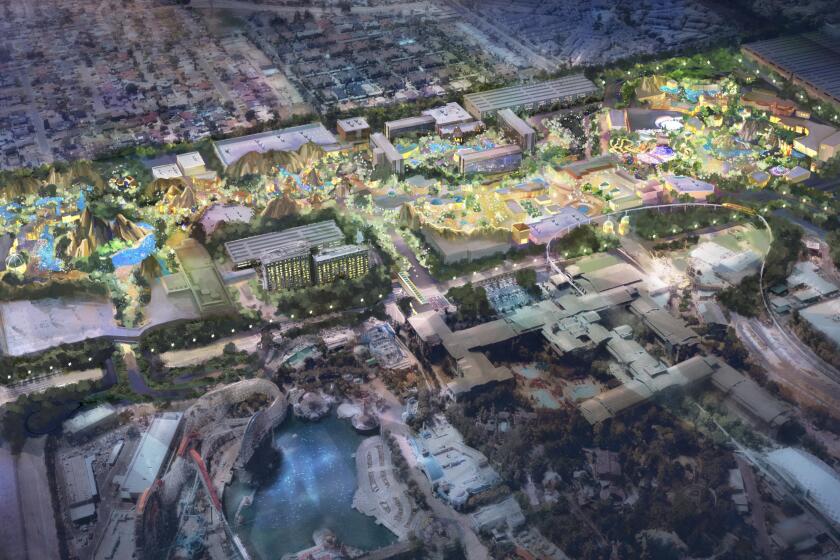Disneyland’s renovation plan gets environmental review

- Share via
Walt Disney Co.’s long-term plan to upgrade and renovate its Anaheim theme park and resort has reached another milepost with the release of a report that details how the project will affect the environment.
Anaheim released a 17,000-page environmental impact report on Thursday for DisneylandForward, which aims to squeeze more attractions, shops and restaurants into the resort’s existing 490-acre footprint.
Although the four-year construction phase will have significant but unavoidable effects on noise pollution, air quality and greenhouse gas emissions in the surrounding community, it won’t negatively affect transportation or neighborhood aesthetics, the report concluded.
To proceed with its plan, Disney must receive approval from Anaheim to rezone various areas of the resort for mixed-use land development. An environmental impact report is required for any new construction to ensure that Disneyland complies with the National Environmental Policy Act and the California Environmental Quality Act. The goal is to disclose a project’s potential effects on the natural and human environment and efforts to mitigate them.
While Walt Disney Co. laid out a robust economic pitch to the city of Anaheim for plans to redevelop its existing theme park footprint, the company did not specify what exactly it wants to build.
To date, Disneyland has not unveiled specific construction plans, but it has cited Tokyo Disneyland’s Fantasy Springs’ Frozen Kingdom and Shanghai Disneyland’s Zootopia-inspired expansion as examples. An “Avatar”-themed experience may also be part of the lineup.
“We cannot even begin to design at that level until we get the guidance of what we can and cannot build,” Rachel Alde, vice president of development for Disney Resorts, said at a media reception Thursday at Disneyland’s headquarters.
The report, which was funded by Disney and commissioned by the city of Anaheim, analyzed 16 potential effects during construction and operations, including energy, water conservation, cultural resources, wildlife and greenhouse gas emissions.
Joe Haupt, chief executive of real estate development firm Spectrum Development Group, said the report assumes a “worst-case scenario” of what could happen. An acoustic engineer, for example, spent two weeks in the park collecting sound profiles to model on a computer how a shift in design could affect noise pollution.
Disney cited key mitigation measures, including installing 12-foot-tall noise barriers and prohibiting aerial firework shows west of Disneyland Drive and in the Toy Story parking lot. To address visual aesthetics concerns, Disneyland will implement a “360-degree architectural design” to improve public views from adjacent residential properties.
Disney announced a plan to add new attractions, shops and restaurants inside Disneyland by redeveloping existing areas of the Anaheim resort.
When Disneyland’s first environmental impact report was conducted in 1993, greenhouse gas emission estimates were not required under California law. Since then, Disney has taken steps to reduce the carbon footprint of park employees’ commutes. With DisneylandForward, the park plans to invest in additional pedestrian bridges, another parking structure and a new transportation center to mitigate traffic.
To address air quality issues, Disneyland said it planned to recycle demolition debris and use low-emission paints, among other mitigation efforts. Many required waste-reduction and energy-efficiency strategies are already in practice at the Anaheim theme park.
Proposed in 2021, DisneylandForward would bring new attractions, shops and eateries onto what the company considers underdeveloped areas of the resort, specifically around two Disney hotels west of the theme parks and on the site of a parking lot east of the resort. The proposal would not expand the park’s square footage.
Existing zoning laws, drafted in 1990, specify which areas of the park may be designated for hotel, retail, dining and theme park attractions. Disney says that for a more diverse and integrative experience that caters to the next generation of consumers, a portion of its land ought to be rezoned for mixed uses. Anaheim’s laws currently do not allow for that. Only 46% of the park’s approved 6.8 millionsquare-feet of space from 1990 has been developed.
Disney made its economic case for the project in May. For every $1 billion Disney invests to redevelop and update Disneyland Resort, the project will generate an estimated $253 million annually in economic output, $15 million in tax revenue, and 2,292 jobs, according to a commissioned report from the Woods Center for Economic Analysis and Forecasting at Cal State Fullerton.
Working at Disneyland isn’t always wonderful, but these former cast members have mostly fond and funny memories of working at the Happiest Place on Earth.
However, the park’s expansion could put pressure on local affordable housing options, said Bill Halligan, a consultant from Harris & Associates who has previously worked on environmental impact reports for Anaheim.
“Any expansion of Disneyland will increase employment, which is a good thing. But the issues in California are related to housing affordability,” Halligan said. “How do you provide adequate housing for the future employees?”
Many Disneyland workers who have struggled to make ends meet may be due for a wage increase soon. In July, a California appellate court ruled that Disneyland illegally evaded a living-wage law passed by Anaheim voters in 2018 that could boost pay for resort workers to nearly $20 an hour.
The environmental report will now enter a 45-day public comment period that will end Oct. 30, after which the city will respond to comments and conduct public information and hearing processes. The first of two public workshops will be held Oct. 9 by the Anaheim Planning Commission. The Anaheim City Council also will host two additional public workshops before issuing a final report and holding hearings. Disney aims to have the project go before the council for a vote by the end of 2024.
More to Read
Inside the business of entertainment
The Wide Shot brings you news, analysis and insights on everything from streaming wars to production — and what it all means for the future.
You may occasionally receive promotional content from the Los Angeles Times.












